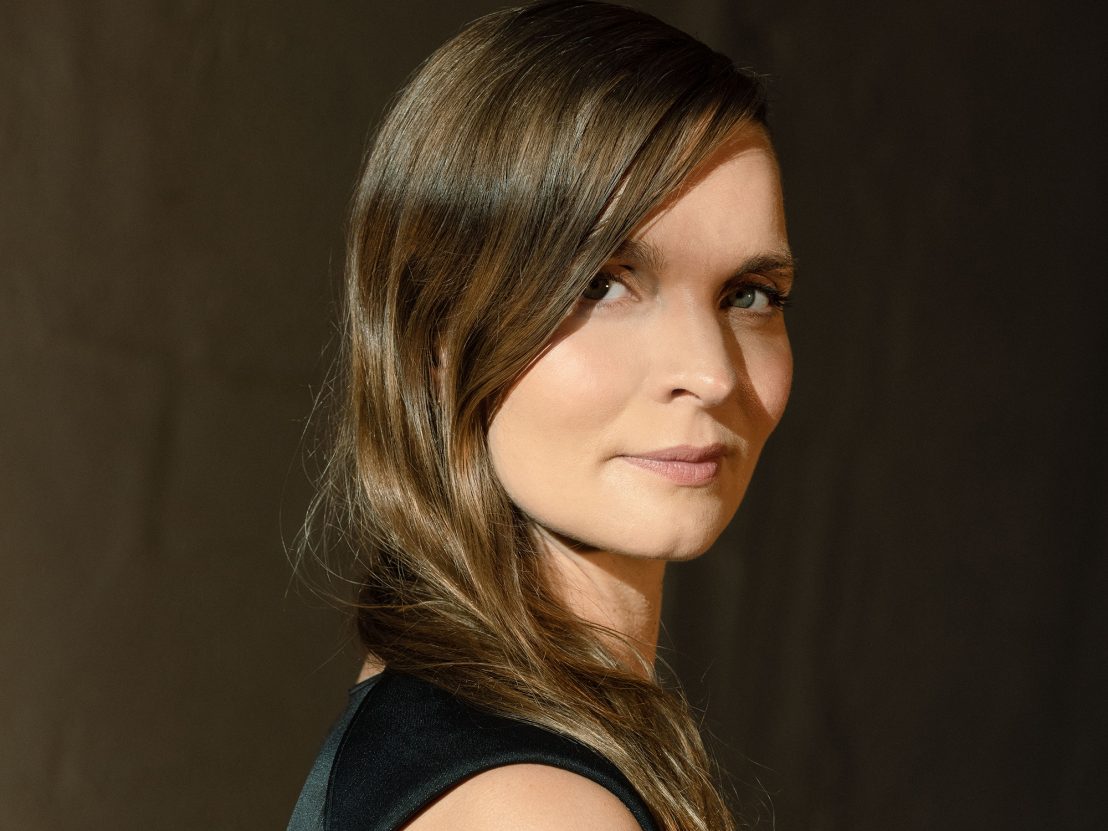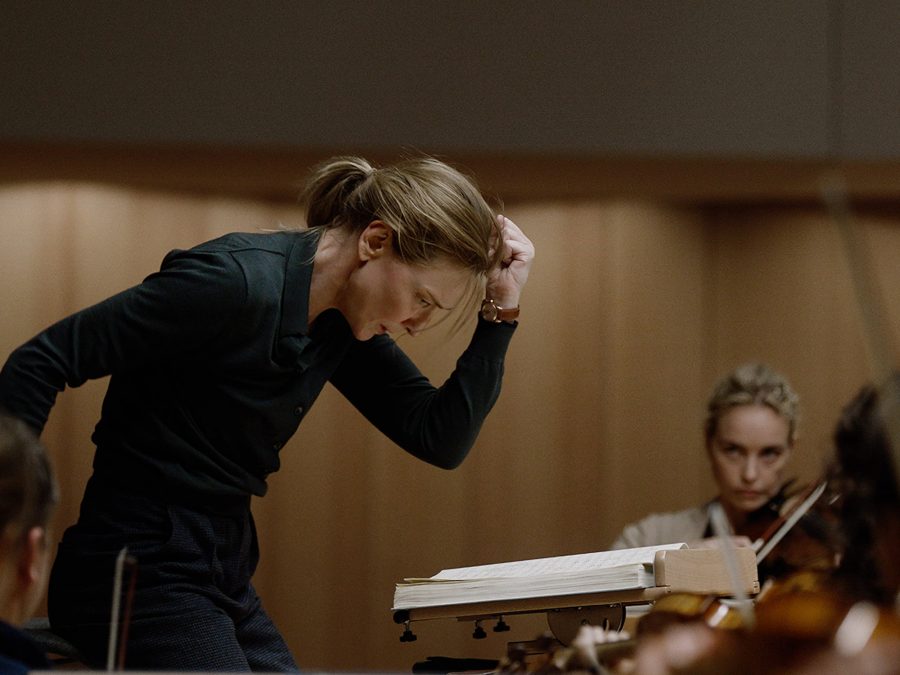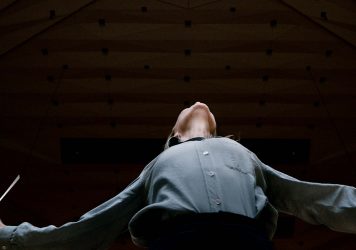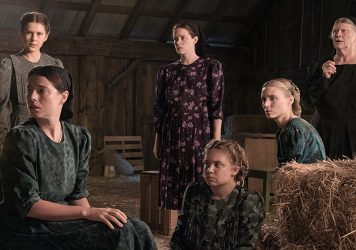
The Academy Award-winning composer behind Tár and Women Talking explains how she created two of this year's most interesting scores.
At first glance, Tár and Women Talking have little in common. Tár is the frantic, bombastic story of a renowned conductor whose orderly life is spiralling out of control. Women Talking, which is set almost entirely in a hayloft, follows a group of Mennonite women as they deliberate over their futures – it is far more measured and sedate. Both, however, feature haunting scores written by Icelandic composer Hildur Guðnadóttir – and both works, though vastly different in their tone and style, are defined as much by their silences as they are by their sounds.
Restraint is typical of Guðnadóttir’s work, who prefers to keep her music free from excess – to distill it into exactly what it needs to be. Often this means long, heavy pauses, or as she puts it, spaces. “My approach to film music is very similar to how I imagine having a conversation goes,” she tells Little White Lies. “I think the most interesting conversations are the ones where each person participating has space, to both contribute to the conversation, and also to take the space to listen.”
Silence and stillness pervade both Tár and Women Talking. As Guðnadóttir told IndieWire of Tár, “The score functions in a way that you barely notice that it is there. You will probably walk out of the film thinking there was no score.” Both films feature long shots with no dialogue and, notably, no ongoing underscoring. This may be jarring to a modern audience used to prominent music in cinema, but it serves a purpose. “In my personal opinion, I feel like a commercial trend in a lot of today’s film music is to pretty much have music under the whole film,” Guðnadóttir explains. “For me as a musician, it’s much more interesting to be particular about where you place the music and to be particular about what the role of the music in the project is.”
Underscoring, Guðnadóttir says, is effectively designed to enhance the emotions portrayed on screen. “If a person is falling in love, you will have sentimental, sweet music to enhance the feeling,” she says. “Music, obviously, is very emotionally manipulative.” Guðnadóttir’s sparse scores aim not to manipulate the audience’s emotions, but rather to elevate important emotional touchstones throughout the stories. “I’m very deliberate about placing music. It’s one of the most effective ways that you can really allow the music to make bigger statements. When you choose your statements, when you choose your phrases more carefully, the music can become almost like a separate character.”
Of course, these musical “characters” are very different in the two films. Women Talking follows a group of women in a remote rural religious group who have come together to discuss their options following a series of attacks from men within their community. No longer feeling safe in their homes, they debate whether to stay, fight, or leave. Their discussion is both heated and heartfelt as several generations of largely uneducated women find themselves wading into a tangled intersection of sexual politics, familial love, community duty and religious belief.
Guðnadóttir landed on a more traditional score for the film. “It’s based on true events, but it’s told as a fable – it could be happening wherever and the timeline is very ambiguous,” she says. “So, the role of the music had to kind of follow that form of narration, so we chose to go about it that kind of rather thematic way, which is a very traditional, old-school way of working.”
The theme that Guðnadóttir and director Sarah Polley found at the heart of the story was that of potential. “The music starts off by telling us, ‘This situation they’re in, it’s horrible – it’s the worst possible situation that you could possibly imagine being stuck in. But there is the opportunity for something out there,'” she says. “That’s what the music tells us right away.” As the film goes on and this spark of potential grows, the score begins to build, too. While the film begins with hardly any musical underscoring, by the time they have reached their final decision, the theme reaches its peak. “The potential opens up and the music leads us through this journey.”

While Women Talking’s score became a thematic beating pulse that drove the story towards its emotional crescendo, Tár’s score operates very differently. Instead of driving an emotional journey, it works to play off of what is essentially a feature film-length character study of a woman in crisis. Guðnadóttir’s score became a sonic portrayal of the inside of her head: “It lives in a more subconscious realm.”
“My role was not just to enhance her story of Lydia Tár with music, but the music was also very much a part of the character itself,” says Guðnadóttir. “I’m writing the music that she’s writing, I’m setting the tempo and the inner landscape of the characters. When you’re writing music, or rehearsing music, that music that you’re living in, it affects your whole life.”
In Tár, the score is composed primarily of Mahler’s Fifth Symphony and an Elgar cello concerto, which the film’s titular character is rehearsing. Alongside the sweeping orchestral sounds of Elgar, Guðnadóttir layers in more ghostly, uncomfortable and increasingly menacing tones. “We have a lot of different types of music that serve various specific roles,” she explains. “We have the musical which she is rehearsing on stage, we have the music that she’s writing, we have the sounds that she’s influenced by that also are very important to her as a character.”
Despite the role of music being so different in each film, the two scores are both precise and relatively sparse, which ultimately means they both serve to make moments and emotions that stand out from the rest.
In Women Talking, the sparsity of music leads to a few key musical moments. First, there are the hymns sung sporadically by the women. Then, there’s the moment when a census collector drives through the community with The Monkees’ “Daydream Believer” blasting from his car’s speakers. In a film filled with silence, the raw, a capella voices of the women and the almost otherworldly sounds of The Monkees become emotional gut punches reminding the audience of the women’s resilience, strength and isolation.
The final big moment comes in the film’s final scene when the women finally take their first steps away from the community towards a new life. “It’s all leading up to the end, where, spoiler alert, they actually leave – that, for me, was definitely the big moment.” In these moments, Guðnadóttir’s theme finally blossoms into its final, full form: “That’s the only moment where we really hear a full orchestra and it becomes very full and large for the first time to really dig into that potential.” And with the full theme comes the satisfying, but heart-wrenching final emotional blow.
“I shouldn’t admit this, but the first time I set up the last scene and I scored the last scene, I started crying,” says Guðnadóttir.
Tár, on the other hand, doesn’t lead to one final moment of emotional release. Instead, it’s punctuated by small, unexpected moments throughout, and the score follows suit. The moments that stand out are often linked to Lydia’s relationship with music. “One moment that I wanted to be very clear, is the moment when Olga changes this one note in Lydia’s melody,” says Guðnadóttir. “The melody changes so drastically. Even though we can feel very stuck with what we’re creating, it will be the smallest change that can have a very big impact on how you experience the melody.”
There is one other striking similarity between the two films – the musical scores play with the delicate battles for control that the women in both films are quietly or not so quietly waging. We have Lydia Tár, a world-famous maestro, whose obsession with control goes beyond her role as conductor and spans from her domineering approach to her assistant and proteges all the way to the precise cuts of her tailored suits. And then we have the women of Women Talking, who grapple for a modicum of control in a world where it is stripped from them at birth. And at the centre of both battles for control is music.
“The music – it’s almost creating a way out for the women in both films,” Guðnadóttir says. “Because Lydia Tár creates this fictional character for herself to kind of create a path out of this life that she’s born into – you know, she’s just Linda from New Jersey.”
“And obviously, in Women Talking, the music is the driving force out of the rough and into the light,” adds Guðnadóttir. “Ultimately, it’s about music being a vehicle of expression. And music is such a beautiful way of expression – it’s a way to express yourself beyond words.”
Published 12 Jan 2023

By Ege Apaydın
Cate Blanchett is on top form as a conductor who experiences a swift fall from grace in Todd Fields' piercing psychodrama.

Todd Phillips’ supervillain origin story strains so hard for seriousness and relevance that it cracks into a million pieces.

A group of women meet in secret to discuss escaping their abusive, isolated colony in Sarah Polley's adaptation of Miriam Towes' novel.